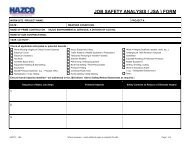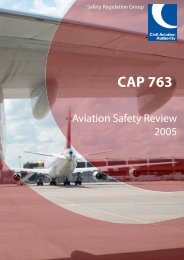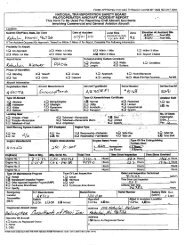International Helicopter Safety Team Safety Management System Toolkit
IHST - Safety Management Toolkit - Skybrary
IHST - Safety Management Toolkit - Skybrary
- No tags were found...
Create successful ePaper yourself
Turn your PDF publications into a flip-book with our unique Google optimized e-Paper software.
Likelihood – the estimated probability or frequency,<br />
in quantitative or qualitative terms, of an occurrence<br />
related to the hazard.<br />
Line management – the management structure that<br />
operates (controls, supervises, etc) the operational<br />
activities and processes of the aviation system.<br />
Nonconformity – non-fulfillment of a requirement<br />
(ref. ISO 9001-2000). This could include but is not<br />
limited to, noncompliance with Federal regulations,<br />
company requirements, requirements of operatordeveloped<br />
risk controls or operator-specified policies<br />
and procedures.<br />
Objective – the desired state or performance target<br />
of a process. Usually it is the final state of a<br />
process and contains the results and outputs used<br />
to obtain the desired state or performance target.<br />
Operational life cycle – time period from implementation<br />
of a product/service until it is no longer<br />
in use.<br />
Organization – indicates both certificated and noncertificated<br />
aviation organizations, aviation service<br />
providers, air carriers, airlines, maintenance repair<br />
organizations, air taxi operators, corporate flight<br />
departments, repair stations, and pilot schools.<br />
Outputs – the product or end result of an SMS<br />
process, which is able to be recorded, monitored,<br />
measured, and analyzed. Outputs are the minimum<br />
expectation for the product of each process area<br />
and the input for the next process area in succession.<br />
Each of the outputs of a process should have<br />
a method of measurement specified by the organization.<br />
Measures need not be quantitative where<br />
this is not practical; however, some method of<br />
providing objective evidence of the attainment of<br />
the expected output is necessary.<br />
Oversight – a function performed by a regulator<br />
(such as the FAA) that ensures that an aviation<br />
organization complies with and uses safety-related<br />
standards, requirements, regulations, and associated<br />
procedures. <strong>Safety</strong> oversight also ensures that<br />
the acceptable level of safety risk is not exceeded<br />
in the air transportation system.<br />
Preventive action – preemptive action to eliminate<br />
or mitigate the potential cause or reduce the future<br />
effects of an identified or anticipated nonconformity<br />
or other undesirable situation.<br />
Procedure – a specified way to carry out an activity<br />
or a process.<br />
Process – a set of interrelated or interacting activities<br />
that transform inputs into outputs.<br />
Process measures – refer to definition for Process<br />
Measures under the Attributes<br />
definition, above.<br />
Product/service – anything that is offered or can<br />
be purchased that might satisfy a want or need in<br />
the air transportation system.<br />
Records – evidence of results achieved or<br />
activities performed.<br />
Residual safety risk – the safety risk that exists<br />
after all controls have been implemented or<br />
exhausted and verified. Only verified controls can<br />
be used for assessing residual safety risk.<br />
Risk – the composite of predicted severity (how bad)<br />
and likelihood (how probable) of the potential<br />
effect of a hazard in its worst credible (reasonable<br />
or believable) system state. The terms risk and<br />
safety risk are interchangeable.<br />
Risk control – steps taken to eliminate (remove)<br />
hazards or to mitigate (lessen) their effects by<br />
reducing the severity and/or likelihood of risk associated<br />
with those hazards.<br />
<strong>Safety</strong> assurance – a formal management process<br />
within the SMS that systematically provides confidence<br />
that an organization’s products/services<br />
meet or exceed safety requirements. A <strong>Safety</strong><br />
Assurance flow diagram (Error! Reference source<br />
not found., found in section Error! Reference source<br />
not found.) includes the Framework<br />
element/process numbers and other notes to help<br />
the reader visualize the Framework in terms of a<br />
process flow (with interfaces), and understand the<br />
component/element/process expectations.<br />
<strong>Safety</strong> culture – the product of individual and<br />
group values, attitudes, competencies, and patterns<br />
of behavior that determine the commitment to, and<br />
the style and proficiency of, the organization’s<br />
management of safety. Organizations with a positive<br />
safety culture are characterized by communications<br />
founded on mutual trust, by shared perceptions<br />
of the importance of safety and by confidence<br />
in the efficacy of preventive measures.<br />
SMS <strong>Toolkit</strong> 95







